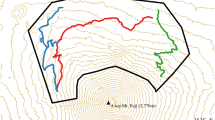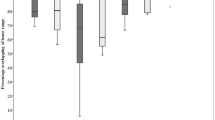Abstract
We studied the impact of group size on foraging behaviour and level of movement synchronisation among female herdmates of a fallow deer population in Central Italy. Both proportion of foraging events and movement synchronisation decreased with increasing group size. The proportion of foraging events was higher for animals on the edge of the group than for deer in the centre of the group; hence, there appears to be a trade-off between protection against predators and foraging interference, both of which decrease from the centre to the periphery of the group. This is the first time this type of behaviour has been recorded for wild ungulates. As expected, we also found that the movement of peripheral animals was less synchronised than that of central animals. Consequently, peripheral animals may lose contact with their herdmates and split off the group. We conclude that social inequalities may lead to conflicting requirements among group members and instability of large groups. Movement synchronisation (as a function of group size) appears to interact with habitat openness to produce variations of group size (which appear to be adaptive for individuals) as an emergent property of these aggregations.






Similar content being viewed by others
References
Alexander McNeill R (2004) Hitching a lift hydrodynamically—in swimming, flying and cycling. J Biol 3:7 (electronic publication)
Apollonio M, Focardi S, Toso S, Necci L (1998) Habitat selection and group formation pattern of fallow deer Dama dama in a submediterranean environment. Ecography 21:225–234
Batschelet E (1981) Circular statistics in biology. Academic Press, London
Beecham JA, Farnsworth KD (1999) Animal group forces resulting from predator avoidance and competition minimization. J Theor Biol 198:533–548
Berger J, Cunningham C (1994) Bison: mating and conservation in small populations. Columbia University Press, New York
Berthold P (1996) Control of bird migration. Chapman & Hall, London
Brashares JS, Garland T, Arcese P (2000) Phylogenetic analysis of coadaptation in behaviour, diet and body size in the African antelope. Behav Ecol 11:452–463
Conradt L, Roper TJ (2000) Activity synchrony and social cohesion: a fission–fusion model. Proc R Soc Lond Ser B 267:2213–2218
Couzin ID, Krause J, James R, Ruxton GD, Franks NR (2002) Collective memory and spatial sorting in animal groups. J Theor Biol 218:1–11
Focardi S, Marcellini P, Montanaro P (1996) Do ungulates exhibit a food density threshold? A field study of optimal foraging and movement patterns. J Anim Ecol 65:606–620
Focardi S, Farnsworth K, Poli BM, Ponzetta MP, Tinelli A (2003) Sexual segregation in ungulates: individual behaviour and the missing link. Pop Ecol 45:83–95
Gilbert BK, Hailman JP (1966) Uncertainty of leadership rank in fallow deer. Nature 209:1041–1042
Gerard J-F, Loisel P (1995) Spontaneous emergency of a relationship between habitat openness and mean group size and its possible evolutionary consequences in large herbivores. J Theor Biol 176:511–522
Gerard J-F, Bideau E, Maublanc M-L, Loisel P, Marchal C (2002) Herd size in large herbivores: encoded in the individual or emergent? Biol Bull 202:275–282
Gueron S, Levin SA (1995) The dynamic of group formation. Math Biosci 128:243–264
Hamilton WD (1971) Geometry of the selfish herd. J Theor Biol 182:85–98
Jarman PJ (1974) The social organization of antelopes in relation to their ecology. Behavior 48:215–266
Krause J, Ruxton GD (2002) Living in groups. Oxford University Press, Oxford
Lindström K, Ranta E (1993) Foraging group structure among individuals differing in competitive ability. Ann Zool Fenn 30:225–232
Okubo A (1980) Diffusion and ecological problems: mathematical models. Biomathematics, vol 10. Springer-Verlag, Berlin Heidelberg New York
Owens T, McConville D (1996) Geospatial application: estimating the spatial accuracy of coordinates collected using the Global Positioning System. National Biological Service, Environmental Management Technical Centre, Onalaska, Wisconsin, LTRMP 96-T002, 13 pp. ftp://ftp.umesc.usgs.gov/pub/media_archives/documents/reports/1996/96t002.pdf
Owen-Smith N (1979) Assessing the foraging efficiency of a large herbivore, the kudu. S Afr J Wildl Res 9:102–110
Parrish JK, Edelstein-Keshet L (1999) Complexity, pattern, and evolutionary trade-offs in animal aggregation. Science 284:99–101
Parrish JK, Viscido SV, Grünbaum D (2002) Self-organised fish schools: an examination of emergent properties. Biol Bull 202:296–305
Pignatti S, Bianco PM, Tescarollo P, Scarascia Mugnozza GT (2001) La vegetazione della Tenuta Presidenziale di Castelporziano. Accademia Nazionale delle Scienze detta dei XL, Scritti e Documenti 26:441–708
Prins HHT (1996) Ecology and behaviour of the African buffalo. Social inequality and decision making. Chapman & Hall, London
Réale D, Festa-Bianchet M (2003) Predator-induced natural selection on temperament in bighorn ewes. Anim Behav 65:463–470
SAS Institute Inc. (2000) SAS OnlineDoc, Version 8, SAS Institute Inc. http://www.sas.com/ts
Sibly RM (1983) Optimal group size is unstable. Anim Behav 31:947–948
Sokal RR, Rohlf FJ (1995) Biometry, 3rd edn. Freeman, New York
Thouless CR (1990) Feeding competition between grazing red deer hinds. Anim Behav 40:105–111
Underwood R (1983) The feeding behaviour of grazing African ungulates. Behaviour 84:195–243
Acknowledgements
We thank the Segretariato alla Presidenza della Repubblica for permission to work at Castelporziano and P Montanaro for helping with field work. JF Gerard reviewed a first draft of the paper and gave us relevant comments. M Festa Bianchet and an anonymous referee provided useful comments and corrections to the manuscript. HC Hauffe corrected the final manuscript
Author information
Authors and Affiliations
Corresponding author
Additional information
Communicated by M. Festa-Bianchet
Rights and permissions
About this article
Cite this article
Focardi, S., Pecchioli, E. Social cohesion and foraging decrease with group size in fallow deer (Dama dama). Behav Ecol Sociobiol 59, 84–91 (2005). https://doi.org/10.1007/s00265-005-0012-0
Received:
Revised:
Accepted:
Published:
Issue Date:
DOI: https://doi.org/10.1007/s00265-005-0012-0




